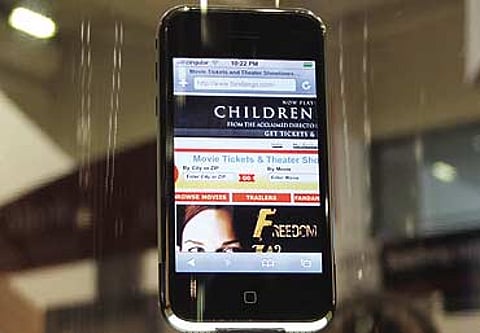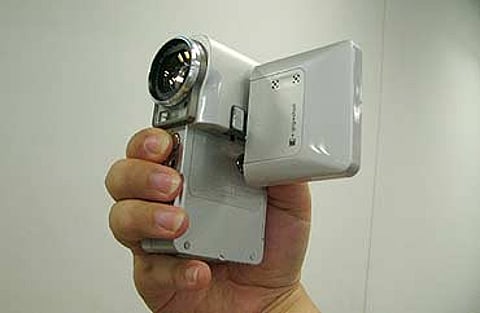Pocket Cosmos
Movies on your palm, ear canal-fitting phones, what's next?

Today's portable computing is stretching the meaning of portable. I came across a slick product from the Sony stable—the VAIO UX. Arguably one of the most diminutive Windows XP-capable computers in existence, it is about the size of a pocket diary and comes in at a feather-light 550 grams. This palm-sized package is powered by a new-generation 1.20 GHz Intel Core Solo U1400 ultra-low-voltage processor, 512 MB of ram and a 30 GB hard disk drive. It gets better—there's a bright 4.5-inch widescreenTFT display, Bluetooth and Wi-Fi LAN included along with two cameras for handling web conferences and for taking pictures. All of this at about $1,800.
Your music following you as you walk from one room to the next? The Philips Streamium realises this dream too. This multimedia device holds about 10,000 MP3 songs and wireless-streams it in high fidelity across your house. Its black plexiglass and chrome finish is a head-turner. Every unit features an FM tuner, plus the ability to accept several audio sources like your iPod and to be linked to your primary audio system. The speakers are integrated into the unit in unobtrusive, sound-radiating panels. It comes in with the base unit at $699, with every additional remote station at $299 a pop.

Are you compulsive about recording every family moment, putting it on to aDVD and regaling the family each time they visit? If they've been complaining about your quirks this far, the Toshiba Gigashot V10, with its crystal-clear, HD-quality video, should shut them up in shock and awe. Best of all, you won't pull a tendon while chasing your toddler around the house with the device. Fitting smugly in the palm of your hands, this still/video camera can pack in about 85 minutes of high-definition recording or about 2,000 full-resolution images from its 5 megapixel sensor—all on its 4 GB integrated Microdrive hard disk. Giving in to this whim will set you back by about $699.


Driving this rampant innovation and drool-worthy gadgets are several awesome technologies cooking in the labs of physicists around the world. Stretching from processors to wireless networks, scientists are not only pushing the limits of the world around us, but reinventing them altogether. Moore's Law of the numbers of transistors on a processor doubling every 18 months is still holding. We've seen the consequences of this in the array of dual and quad-core processors that are now so commonly available. All this has happened thanks to the scientists at Intel, AMD and IBM who've managed to shrink their fabrication processes to ever-decreasing levels. Right now, the processors based on the 65 nanometer process are available on both the desktop and laptop fronts. However, the upcoming breed of processors (such as Intel's 'Penryn' family) will be shrunken down to 45 nanometers—an interestingly small number when you consider the fact that just 90 transistors from this processor can be strung along the diameter of a typical atom. So what does this foretell? For one, there's a very bright future for processors. Quad-core is just the beginning. The ability to pack more circuits into a typical wafer of silicon will spawn 8, 16, maybe even 32-core processors. This can lead to even more exciting era of distributed computing on personal gadgets and home entertainment devices.

When was the last time you had your cellphone or laptop die on you? Last night? Power sources for mobile devices are poised to get a steroidal shot-in-the-arm with technologies that will not only juice your favourite gadgets, but be environment-friendly also. Termed as 'Fuel cell', this proposed form of power will use a form of external fuel (such as methanol gas), and can be used in applications ranging from cellphones to clean cars. Working prototypes of these devices have already been launched (check out www.bmw.com or www.toyota.com for some super-cool enviro-friendly cars). Portable gadgets based on it are not far behind. With their obvious advantages of low-cost, super-long battery life and safety, it is certain to make its way into lifestyle applications.
The Swiss-made bicycle (the SLC 01 from BMC) ridden by Floyd Landis in the 2006 Tour de France was like none other. It was bolstered with a technology that made it tougher than steel while still weighing only one kg. The same is used to create tough, athletic clothing that breathes easier, combat gear that can withstand explosions, and even to facilitate faster, smaller computers. The technology involves Carbon Nanotubes—carbon atoms rolled into tubes with a diameter of just a few nanometers. These ultra-tiny structures have fascinating physical properties—they are tougher than virtually any man-made material, have electrical properties that can facilitate the creation of ever-smaller electrical circuits, and are inexpensive to produce.
With advancements in this field, expect to see some fascinating products finding their way into markets this year.
Tags